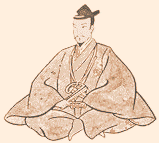
|
|
The dissent and disillusionment of the samurai
was finally exploited by Emperor Go-Daigo
(1287-1339), who raised an army, led by Ashikaga
Takauji, with the objective to restore sovereignty to the imperial
line. The capture of Kamakura and then Kyoto ensured the demise of
the Hojo. In 1333 the Emperor declared the abolishment of the shogunate.
Kyoto, was once again the capital.
 The Ashikaga Shoguns: 1336-1559
The Ashikaga Shoguns: 1336-1559
The Emperor, however, erred when he rewarded the nobles, who did not
fight at the battle front. The samurai, again were discontent.
Finally the clan leader, Ashikaga Takauji (1305-58), rebelled against
the dynasty. He drove Emperor Go-Daigo, out of Kyoto, and replaced
him with a rival emperor, Kogon (1313-1364).
Takauji, was then appointed shogun in 1336. For the next 60 years
Japan had two emperors: Go-Daigo, who declared himself the only legitimate
emperor fled to Yoshino, a region south
of Nara in Honshu; and Kogon in the north at Kyoto. The next fifteen
ruling shoguns would be from the Ashikaga clan.
Nambokucho War: 1333-1392
This period of civil war between the 'north and south dynasties' continued
for some 60 years. The Ashikaga together with their allies fought
the southern supporters of Go-Daigo. The war came to an end when Daigo's
third successor renounced his claim to the throne and was persuaded
to relinquish the sacred imperial regalia. The Ashikaga then tried
to reunify the country and a brief period of peace ensued.
In general, the period of Ashikaga ascendancy was one of great refinement
of manners, of great art and literary endeavour. No theatre flourished
and the tea ceremony, Cha-no-yu was raised
to that of an art form. Buddhism developed as a political force, their
monasteries had become wealthy and powerful. Buddhist monks, clad
in armour and bearing weapons, often turned the tide of battles with
their strong organisations and fortified monasteries.
Sengoku-Jidai, 'The Age of War': 1467-1568
Succession disputes were again the primary cause for this war which
tore Japan apart. The first ten years are known as the Onin
War 1467-1477. The powerful daimyo (independent,
land-owning lords), Hosokawa Katsumoto,
raised an army and began hostilities by attacking the Isshiki mansion,
close to the shogun's palace. Battle was brought to the streets of
Kyoto. The shogun was forced to declare the Hosokawa the loyal army,
but the warring continued. The sovereignty of the Muromachi shogunate
was disabled and all daimyo became involved in the wars which spread
throughout Japan.
1543: First firearms brought to Japan
from Portugal.
1549: Christianity is introduced by Fracisco
De Xavier.
An armistice was finally agreed between the houses of Hosokawa and
their main opposition the Yamana, but not
all battles ceased, many daimyo continued fighting for power, territory
and the claim to shogun. By the end of this long period of conflict
the once powerful daimyo, had all but obliterated each other and a
new type of regional ruler began to emerge; the Sengoku-Daimyo.
These were completely independent samurai warlords with great power.
The Ashikaga shogunate was finally brought down by the daimyo Oda
Nobunaga. |
|


